The next stage in Marina Bay’s evolution
As the area continues to evolve as a vibrant urban precinct, stakeholders will have to actively address issues from economic uncertainties to climate change

The future of Marina Bay and Singapore’s CBD will be shaped by our ability to embrace innovation, flexibility and inclusivity in urban planning.
IN PRIME Minister Lawrence Wong’s National Day Rally speech this year, he outlined plans to advance Singapore’s vision for Marina Bay. By adding more than 10,000 new homes at Marina South and Marina East, the government aims to create a vibrant day-to-night and environmentally-friendly Marina Bay where people can live, work and play. As the Central Business District (CBD) transitions from a commercial district to one with more live-in community, Marina Bay stands as a living lab for the urban future. This vision is a work in progress.
In addition to the introduction of more mixed-use developments, such as the newly-completed IOI Central Boulevard Towers and the upcoming redevelopment of AXA Tower, city planners have also offered carrots to draw private owners to redevelop their functionally inefficient office blocks that come alive only during work hours. Incentivising renewal could create more activity-generating amenities that would spawn a captive night population. Such projects, which are more representative of urban necessities, are aligned with the CBD Incentive Scheme, which is in its fifth year and up for possible renewal.
As Marina Bay continues to evolve as a vibrant and attractive urban precinct, stakeholders will have to actively address dynamic issues. These include economic uncertainties, shifting demographics, diverse societal needs, and climate change. An open mind for experimentation and adaptation alongside ongoing community dialogue through the various Business Improvement Districts (BIDs) will allow firm planners and stakeholders to collectively ensure the success of this transformation.
Economic push and pull
Globally, CBDs have undergone a significant transformation in recent years. A trend of office decentralisation for commercial growth and urban efficiencies has been gaining momentum. In Singapore, the Urban Redevelopment Authority (URA) has been promoting new growth hubs to offer businesses wider options. Examples of this include commercial hubs established in Tampines as far back as in 1999 and, more recently, in Jurong Lake District.
Furthermore, the Covid-19 pandemic has also dramatically altered the way we work. The rise of hybrid and remote work arrangements has led to lower office utilisation rates and created operational cost concerns for firms. In Singapore, a 2023 survey found that 85 per cent of workers desired flexibility at work. This has motivated many firms to explore alternative locations outside of the CBD.
That said, the current rental gap between CBD and offices in the outer regions has narrowed and does not provide significant financial incentives to motivate outward migration. Post Covid-19, the rental gap between CBD and decentralised offices has hovered around 32 to 33 per cent according to JLL data. This is down from 35 to 37 per cent seen between 2018 and 2019, prior to the pandemic, suggesting a possible gravitational pull back towards the CBD.
With no new land sales in the foreseeable future plus the cap on office quantum in the CBD, this could result in higher office rentals in the near term as a response to tighter supply and begin to challenge the long-term importance and attractiveness of the CBD office market. The planning approach to Singapore’s CBD must evolve to meet new needs while retaining commercial relevance if it wants to achieve the vision of a stronger live-work-play environment.
A flexible, people-first lens
In a post-pandemic world, lifestyles and work habits have evolved significantly, and the lines between work and home spaces have blurred correspondingly. Interestingly, despite the increasing prevalence of digital interactions in our daily lives, physical spaces are becoming more valued than ever. This paradox emphasises the importance of tangible experiences in fostering a sense of community and belonging.
To address these, the development of Marina Bay must adopt a people-centric approach, prioritising the creation of environments that adapt to changing aspirations. URA’s plan to utilise the 18-ha open space around Marina One for recreation and play is a good example of meeting community and recreational needs. Another interesting concept is the activation of privately owned public spaces (POPS), which uses spaces within buildings to create a more active urban atmosphere. These uses and other novel ideas, such as pet-friendly infrastructure, that can uplift community living should continue to be trialled as we inject more life into the city, but continual engagement with stakeholders will be key to the success of creating a liveable and inclusive community to make it a delightful neighbourhood.

Globally, CBDs have undergone a significant transformation in recent years. A trend of office decentralisation for commercial growth and urban efficiencies has been gaining momentum. PHOTO: JASON QUAH, ST
Future developments in Marina Bay will need to offer a rich variety of amenities and experiences that cater to diverse communities, including office workers, leisure travellers, and prospective residents, thereby creating vibrant, multifaceted urban environments. In Tanjong Pagar, for example, where businesses support a more varied crowd from office buildings, residential apartments and hotels, retail business hours are generally longer, potentially up to seven days a week. In time to come, perhaps a review of the regulations pertaining to opening hours at entertainment venues could foster an even more vibrant live-in and night population in the Marina Bay area.
Furthermore, as needs evolve, flexibility will be key to future-proofing buildings, and structures will be required to accommodate multiple uses throughout their lifespan. This will ensure that spaces adapt to shifting demands and remain relevant over time. It will also support the transition towards a more sustainable future that prioritises reuse over new construction.
Smart and sustainable urban spaces
Singapore’s CBD is particularly vulnerable to the urban heat effect. Along with minimising environmental impact, heat resilience will be a key focus for future building designs in Marina Bay. Emerging digital technologies and smart materials will play an increasingly large role in shaping a more sustainable live-work-play environment.
Technology is transforming the very way we design, build and experience physical spaces. Innovations such as smart glass incorporating natural materials such as clay, advanced ventilation systems, and cool roof technologies will help regulate internal temperatures while minimising the building’s impact on the external environment. In the future, artificial intelligence will go beyond simply reacting to changes; it will predict usage patterns and proactively adjust building systems for optimal efficiency.
More flexible planning regime
Alongside new thinking on use and construction, the planning application process should also evolve. To harness the diversity and fluidity of future usage, evaluating and approving redevelopment projects should be correspondingly nimble and adaptive.
A CBD task force comprising urban designers, development control planners and other stakeholders could deliberate and engage with landowners on their redevelopment plans at an early stage. This platform would also facilitate a circular flow of information between the private and public stakeholders and serve to inform the urban planners of the future CBD.
The engagement process could be a more communicative or dialogue approach, evaluating each case on its own merit. This would help reshape the urban future of Singapore’s CBD in a more organic, market-focused manner and embrace stakeholders in a more sensitive way.
A CBD of tomorrow
Marina Bay’s evolution represents a critical juncture in Singapore’s urban development. As we navigate the complexities of economic shifts, changing work patterns, and environmental challenges, the vision for Marina Bay must remain adaptable and responsive. The success of this transformation will hinge on the collective efforts of policymakers, developers, businesses and residents to create a truly integrated and sustainable urban ecosystem that balances commercial vibrancy with liveability and environmental consciousness.
Looking ahead, the future of Marina Bay and Singapore’s CBD will be shaped by our ability to embrace innovation, flexibility and inclusivity in urban planning. By fostering a dynamic environment that can adapt to evolving needs, leveraging smart technologies for sustainability, and prioritising human-centric design, we can ensure that Marina Bay not only meets the demands of today but also sets a global standard for urban development in the years to come.
As this living laboratory of urban innovation continues to evolve, it will serve as a testament to Singapore’s commitment to creating a resilient, sustainable, and vibrant city for generations to come.
This article was first published in The Business Times on Oct 19, 2024




